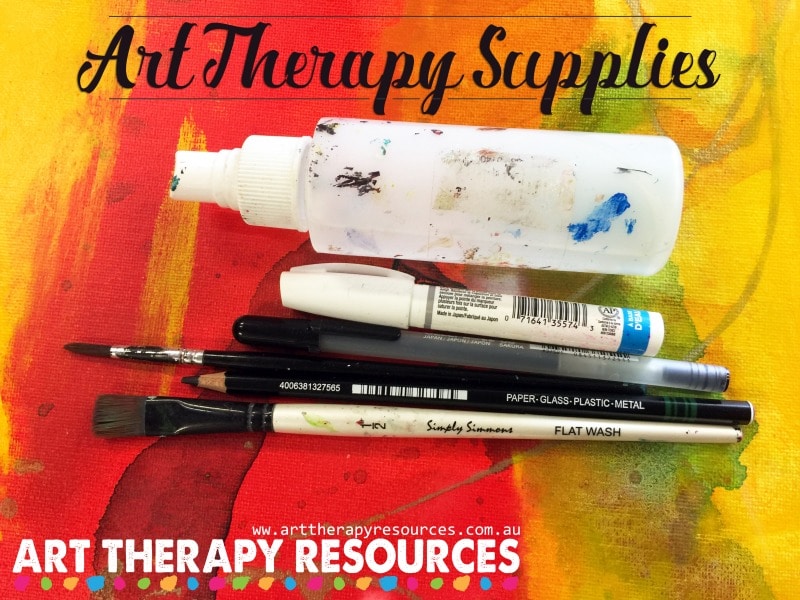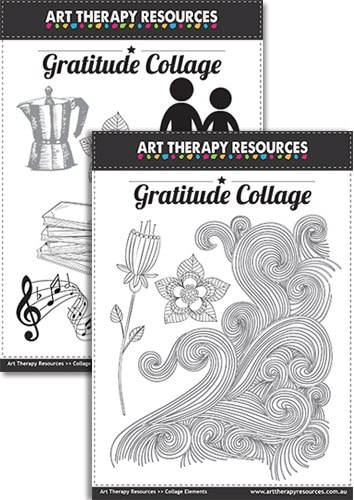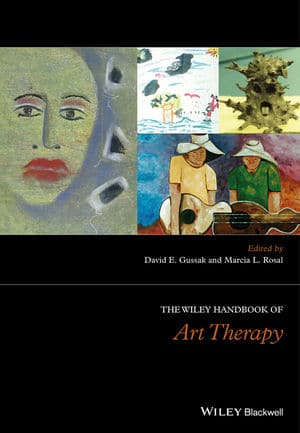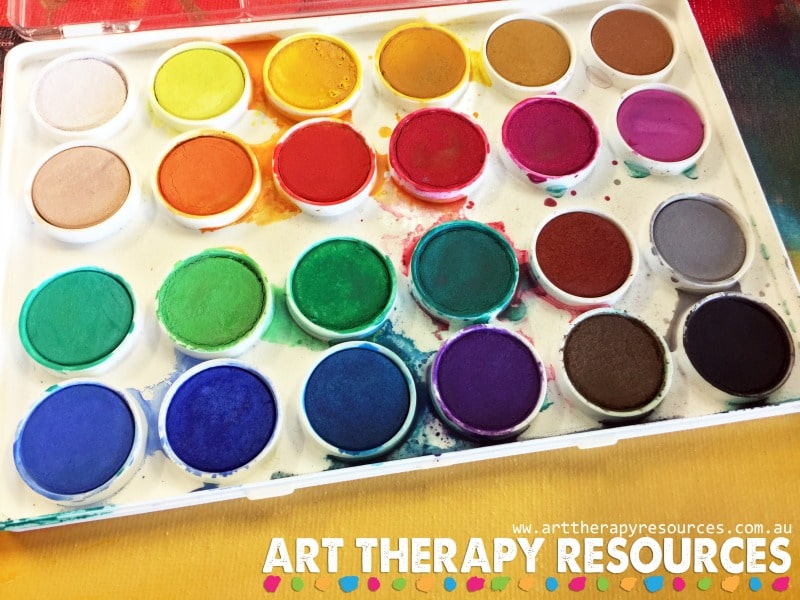THIS POST INCLUDES:
1. The Wiley Handbook of Art Therapy
2. A review of the Wiley Handbook of Art Therapy
3. Summary
4. Art Therapy Exercise + FREE Downloadable Gratitude Collage Elements
THE WILEY HANDBOOK OF ART THERAPY
Title: The Wiley Handbook of Art Therapy
Author: Wiley-Blackwell
Author website/facebook: Wiley-Blackwell, Facebook
Date published: October 2015
Page length: 912 pages
Contents: 84 chapters in total. DOWNLOAD TABLE OF CONTENTS
Amazon purchase link: The Wiley Handbook of Art Therapy
Goodreads link: The Wiley Handbook of Art Therapy
ABOUT THE BOOK
About the book (from the publisher):
The Wiley Handbook of Art Therapy is a collection of original, internationally diverse essays, that provides unsurpassed breadth and depth of coverage of the subject.
- The most comprehensive art therapy book in the field, exploring a wide range of themes
- A unique collection of the current and innovative clinical, theoretical and research approaches in the field
- Cutting-edge in its content, the handbook includes the very latest trends in the subject, and in-depth accounts of the advances in the art therapy arena
- Edited by two highly renowned and respected academics in the field, with a stellar list of global contributors, including Judy Rubin, Vija Lusebrink, Selma Ciornai, Maria d’ Ella and Jill Westwood
The practice of contemporary art therapy involves reflection on multiple philosophical, theoretical and practice models, and is often dependent on a range of specific settings or populations. Yet until now, the diversity of the profession has not been brought together in a single text.
The Wiley Handbook of Art Therapy resolves the issue by providing unsurpassed breadth and depth of coverage of the subject, through a collection of theoretical and research approaches to practice. The handbook also explores various research models and professional issues, and provides a survey of global perspectives.
There are nine sections, each focusing on a crucial aspect of the field. These include a general overview, materials and directives, developmental continuum, assessments, research, special populations, interdisciplinary relationships, international art therapy, and special and contemporary issues. The result is an authoritative, state-of-the-art collection of the latest research in art therapy. Its multidisciplinary approach makes it a comprehensive and invaluable resource for all those in this field.
The result is an authoritative, state-of-the-art collection of the latest research in art therapy. Its multidisciplinary approach makes it a comprehensive and invaluable resource for all those in this field.
Book Content:
Each of the 9 sections are listed below, along with a number in brackets that indicates the number of chapters in each section.
The first 2 sections contain the building blocks of Art Therapy through exploration of its history and the use of art media.
Part I – Historical and Theoretical Frameworks (12)
Part II – Understanding Art Media in Therapy (7)
The next 3 sections explore the scope of art therapy in practice, including types of activities and the various populations that can benefit from art therapy, eg. substance abuse, eating disorders etc
Part III – Developmental Spectrum and Therapeutic Considerations (9)
Part IV – Art Therapy with Various Populations (12)
Part V – Practising Art Therapy in Interdisciplinary Settings (7)
The next 2 sections cover assessment and research issues within Art Therapy
Part VI – Art Therapy Assessments (10)
Part VII – Research Models in Art Therapy (7)
The final 2 sections explore issues within the Art Therapy Field such as cultural influences and the future for Art Therapy.
Part VIII – Art Therapy Around the World (11)
Part IX – Current and Contemporary Issues in Art Therapy (9)
Each section has about 7-12 chapters, with each chapter written by a different expert in the field. Approximately 90 authors contributed to this book. This approach equates to a lot of content and an enormous variety of input from different perspectives. There is 84 chapter in total.
You can download a summary of all 84 chapters included in the book. You can also view the contents and a few sample chapters of the book on Wiley Handbook of Art Therapy.
A REVIEW OF THE WILEY HANDBOOK OF ART THERAPY
I appreciated the additional content for referencing, and the suggested readings. Each article was heavily referenced, which is a good indicator of the quality of the content. The book also provided a lengthy list of additional resources to explore on my own. These resources provide an avenue to expand on the shorter content (my only dislike – mentioned further on).
A positive aspect of making the chapters shorter meant a number of things could be achieved:
1) a large number of topics could be covered,
2) a large number of authors with various expertise could be used,
3) I could read the book in bite-sized portions of 15 mins at a time by approaching each chapter as a short article
A number of the chapters had content that would have been good to explore further, however, all chapters were presented in a smaller format which made it feel like a series of articles that only covered the surface.
Given the breakdown of the book: 9 sections which were further grouped into 4 key areas, this handbook could have been divided into a number of volumes so that chapters could have been expanded. In its current format, the book provides a one-off purchase with all of the content in one book. Purchasing multiple volumes would be much more expensive and possibly prevent readers from accessing the breadth of the material that was covered by this book.
Historically art therapy has been discussed based on 2 main approaches:
- Art + Psychotherapy where the art activity provides context to the psychological issues of the client
- Art as Therapy where actions of art making is a therapeutic outlet for the client
Art Therapy has developed beyond those 2 approaches and now integrates a broader influence of various psychological theories. Cultural influences also impact the delivery of art therapy as therapists around the world incorporate cultural norms and their own theoretical orientation.
Most other Art Therapy reference books focus on a specific part of the art therapy field, such as:
- Historical perspectives
- Specific populations or diagnosis
- Assessments
- Research
- Art activities
This handbook captures a range of all these areas and more. Hence, 84 chapters and 912 pages.
ART THERAPY EXERCISE
Below is an example exercise from the book. This exercise is featured in chapter 27: Art Therapy with Older Adults: A Focus on Cognition and Expressivity. The chapter was written by Amanda Alders Pike. The exercise is not only applicable to older adults, but can be utilised across a broad range of client demographics.
The task details are taken from the Wiley Handbook of Art Therapy. The supplies list and final art image are provided by Art Therapy Resources. The black and white clipart images were sourced from Freepik Clipart.
TASK: Create a collage of gratitude. Use images to represent experiences and aspects of your life that you are grateful for.
SUPPLIES: Various Freepik clipart images. Liquitex Acrylic Paints and Angora Watercolour Pan Set, Black Stabilo Pencil, White Sharpie Paint Pen X-Fine, Black Jelly Roll Pen, Simply Simmons Brushes, Collage Pauge Decoupage Matte, XL Watercolour Pad (trimmed to 12×12 inch) Scissors, Water Bottle
OUTCOME: Involves visual searching and promotes a positive mood
LIQUITEX ACRYLIC PAINT SET
ANGORA WATERCOLOUR PAINTS:
GENERAL SUPPLIES:
Black Stabilo Pencil, White Sharpie Paint Pen X-Fine, Black Jelly Roll Pen, Simply Simmons Brushes, Collage Pauge Decoupage Matte, XL Watercolour Pad

COLLAGE ELEMENTS DOWNLOAD:

ART THERAPY EXERCISE – GRATITUDE COLLAGE ELEMENTS
Below is a FREE download of some clipart images to use for collage in this Art Therapy exercise.

BUILD YOUR ART THERAPY REFERENCE MATERIALS:
Pin this image to your Pinterest board.

SHARE KNOWLEDGE & PASS IT ON:
If you’ve enjoyed this post, please share it on Facebook, Twitter, Pinterest. Thank you!



